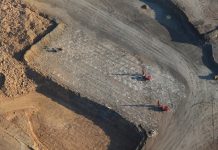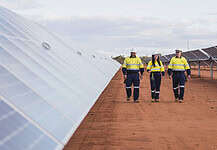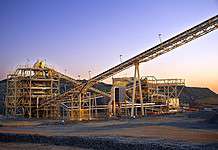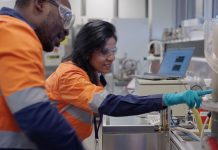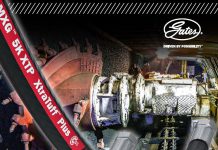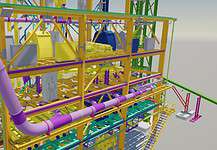In the dusty and corrosive environment of mine sites, it is necessary to keep valuable and expensive parts and components free from potentially destructive elements.
Elements such as dust, moisture, mould and, even light and atmosphere in some cases, can deteriorate and damage items quickly.
More so in underground mining than in surface mining, the improper storage of spare parts and componentry like electronic circuit boards, machine components and workshop items, can dramatically reduce shelf life.
The challenge of keeping items in pristine condition for as long as possible at mine sites is real.
Australian Mining Review spoke to Vacumatic Australia’s director Urs Stucki to discover how his company’s vacuum sealing technology solves the issue of shelf life at mine sites.
Vacumatic Australia
Vacumatic Australia manufactures and exports quality vacuum packaging machines, vacuum chamber machines, tray sealing machines and thermoforming machines to a wide range of industries and sectors.
The company’s range of standard and custom-designed solutions can solve any storage and packaging challenges at mine sites.
Proudly Australian-owned and operated, Vacumatic Australia has its own modern manufacturing, design and research and development facility in Melbourne, Australia.
“We’ve been an engineering company for 35 years,” Urs said. “We do a lot of things including plant, building and equipment but we started with the vacuum technology packaging for the food industry almost four decades ago.”
The company manufactures and supplies quality vacuum packaging machines and bags for food preparation, storage and packing industries in Australia and exports to over eight countries.
Today, Vacumatic Australia’s machines are used in all industries including hotels, butchers, smallgoods manufacturers, cheese producers, defence force packaging of components to prevent corrosion, mine sites, seafood producers, medical, pharmaceutical, government and aged care.
“We create a longer shelf life for items, including a no-shelf-life limit for certain components, which saves our clients a lot of money because they don’t have to replace the items so often,” Urs said.
Variable Specifications
With custom-designed solutions and state-of-the-art technology, Vacumatic Australia can build machines to clients’ technical specifications.
Swiss-born Urs understands the importance of sourcing quality products worldwide and providing reliable and time-efficient service to clients through the company’s overseastrained technicians and qualified engineers.
Technical specification includes, but is not limited to, overall machine size; construction material, for example 304 stainless steel; chamber height; length of sealing bars distance between sealing bars; 100-500 m3/hr Busch vacuum pumps; power and voltage; soft air and double-sealing inclusion; gas flushing facility; and the number of programs, including the material composition of sealing bags.
All types of vacuum sealing functions and capabilities are catered for in Vacumatic Australia’s technology, from atmospheric sealing to gas flushing, block packing capabilities to incline control, inbuilt conveyors to sensor controls, large chambers to swing lids, shrink tunnels with hot water to auto-loading systems.
Mine site applications for the vacuum sealing technology are wide and varied, including safety, components and parts storge, samples and catering.

Safety Items
Safety items cover first aid kids and breathing apparatuses. In underground coal mines, for example in Queensland, mine staff require oxygen sets as a safety requirement.
They are stored in racks in the underground mine, completely sealed off to prevent moisture and mould from creeping.
There is, with absolute certainty, no chance that corrosion and oxidation can happen as the items are completely sealed off and unexposed in any way to the environment underground.
The Vacumatic 1268XL is a specially designed heavy-duty machine for the mining industry.
Featuring a hood and chamber with sealing technology to the front and side of the machine’s tray, and an upgraded electronic and digital control panel for easy and precise operation, it is also suitable for smaller packs including electronics and electrical items, as well as workshop parts.
Stainless steel chambers are standard on all vacuum chamber machines. This custom-made machine is on castors for easy manoeuvrability and, for sanitation purposes, the design makes it easy to clean and wipe down.
First aid kids can also be vacuum sealed in this custom-made machine to prevent product contamination, dampening and rusting.
Using a large special vacuum bag, the heavy duty sealing ensures the original condition of the breathing apparatus and first aid kits for six to 12 months, when they are reopened again for a safety inspection.
Featuring a special large vacuum pump and a more heavy-duty sealing system, the bags used are heavier and thicker than the typical 75-100?m. With thicker material at 150?m, this prevents tears to the bags containing heavier items.
Mining Samples
When it comes to mining, bore and oil samples, a custom-made machine featuring a longer chamber is used to create a narrow pack.
Vacumatic Australia has provided these machines to mines in Papua New Guinea and oil rigs.
“The bags are manufactured to their specification, their thickness, their ?m (micron), including the material,” Urs said.
“Some clients require high oxygen bags, some products have to be sealed off from light, which require aluminium foil or bags, as well as the use of nylon to strengthen the bags.”
Vacumatic Australia works with all sorts of bag and pouch material and can source if they aren’t in stock. In saying that, the company’s clients are typically based in niche markets or may place orders for thousands of bags in one go, therefore custom-made bag stocks are usually ordered as required rather than kept in stock.
“It depends on what the clients want set up and the machines used to custom make these bags,” Urs said.
“We calculate the whole amount for the client and we provide additional support by keeping it in stock for them.”
Vacumatic Australia’s machines are designed to guarantee the best preservation and extend shelf life of any product that requires protection from the elements by providing a safe and efficient method of packing products.

High Volume Catering
In high volume and high output kitchens on mine site villages, efficiency and productivity are the key to well-run catering facilities.
With 35 years servicing the catering, hospitality and food industries, Vacumatic Australia has a solid reputation and extensive understanding of food handling and packing requirements.
Its tray sealing machines can vacuum seal prepared food in modified atmosphere packaging quickly and efficiently.
When there are hundreds of mine staff gathering at the canteen for mealtimes, with everyone packing food before shift start, and kitchen staff cleaning up and packing away vast amounts of leftover food, it is imperative a packing machine can move quickly and reliably with high-output levels.
“It is possible to do the whole kitchen production in a day, then pack it in a few hours on the machine, therefore catering for a whole week in as short amount of time as possible,” Urs said.
Meals can be packed in a tray and simply reopened as a cold dish or reheated, after the sealing film is peeled back. CPET trays, which can take temperatures up to 220o Celsius and are microwavable, are typically used for meals that must be reheated later.
Like the machines, CPET trays come in all different capacities, dimensions and configurations. The tray sealing machines come as either fully automatic inline machines with a single chamber or as manual, freestanding machines.
Gas flush and vacuum are standard. Special features such as soft air can be added.
The production output is around three to eight pieces per minute depending on machine settings.
The top web of packaging material (lid film) covers the filled pockets/trays. The air is evacuated from the sealing die and protective gas is added, using either a vacuum pump or through the gas flushing process.
The pack is then sealed by the application of heat and pressure.
Vacumatics Australia’s machine range extends from compact, table top machines, suitable for the smallest catering operation, to heavy-duty, high capacity, double chamber machines to meet the needs of the largest processor.
All products are backed by after-sales support from the company’s nationwide service network.
Components and Parts
With a track record of supplying vacuum sealing machines to air force bases around Australia, plane components, bearings and electronic parts that are made in the US are stored in antistatic pouches four several years.
“Some of the aeroplanes are decades old, as much as 30 years old, and the air force bases can keep the components in pristine condition for a long time without them ever being destroyed through corrosion and oxidation,” Urs said.
This same vacuum sealing technology is available to the mining industry to store mechanical parts, hardware and workshop items, electrical components and chemical products.
The Vacumatic 1268XL is currently used in some mine sites to protect electronic parts, for example circuit boards, from environmental damage.
After heavy duty sealing, the parts and components can be left in storage without any exposure to oxygen, mould and dust.
Some machines can be custom-made to include conveyor belts, rollers and pulleys, as well as barcoding and lettering systems.
Digital and push button technology on LCD screen panels, including the most up-to-date machinery and inhouse CNC machining, means Vacumatic Australia has the most modern equipment and works to the most modern standards.
Custom-made bags can also be built for a variety of scenarios such as blocking out light, noise reduction, size and shape, toughness and durability.

Service
Vacumatic Australia can visit clients at their premises or mine sites to determine their requirements. The sale of all machines comes with after-sales service on all its equipment.
All the client has to do is to send the machine back to the factory to receive a free service.
Machines are not hired out due to the potential for cross-contamination between industries.
While the company offers maintenance contracts, some bigger clients have their own inhouse engineering and technical departments and may only require training at installation, trial and commissioning of the machines.
Genuine spare parts and equipment are also available for sale. As before, all products are backed by after-sales support from the company’s nationwide service network.
Vacumatic Australia also specialise in CNC machining, reverse engineering, robotics and automation, as well as fabrication and structural.
SOURCE
Vacumatic Australia
P +61 3 5940 0040
E [email protected]
W www.vacumatic.com.au

